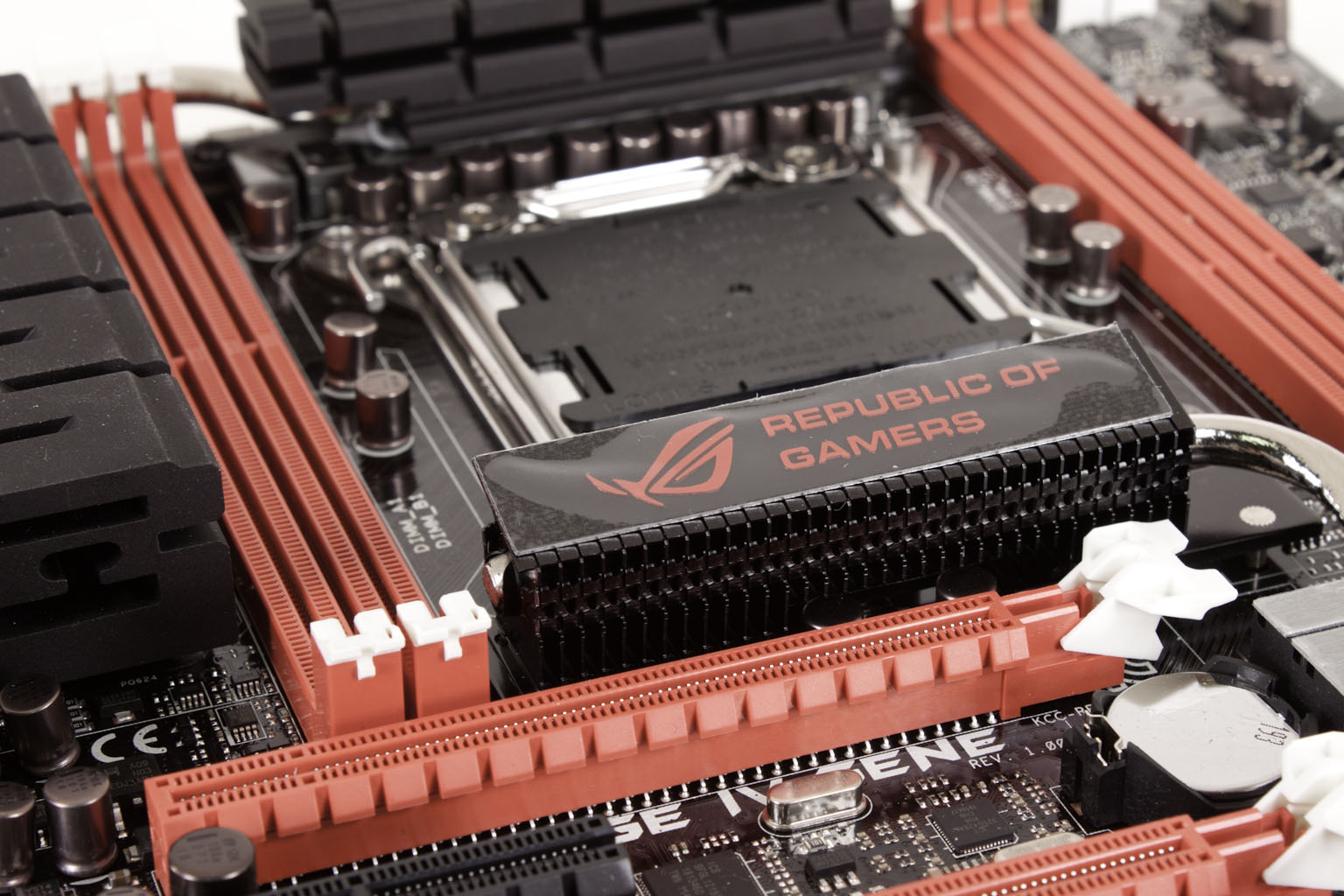BIOS -
BIOS is an acronym that stands for Basic Input/Output System. It is meant to control your product at a very low level. As of right now there are three regularly used BIOS formats (there are actually more than that but there are three common ones). These are the AMI (American Megatrends Incorporated), Award, and Phoenix. Asus has been one of the companies that has really put some time and thought into their UEFI interface. They went out of their way to not only make it look good, but also to make sure it is completely functional. We took some time to show you how it is implemented on the Rampage IV Gene. You can check out our video below.
Overclocking –
Being part of the Republic of Gamers lineup the Rampage IV Gene has some great overclocking tools and support for your tweaking needs. We played with both the Auto Tune settings and also with our own manual attempts. We ended up with a hybrid of options to get our stable overclock of 4.645GHz which, while not the highest we have ever gotten our Core i7 3960 to, is higher than average.
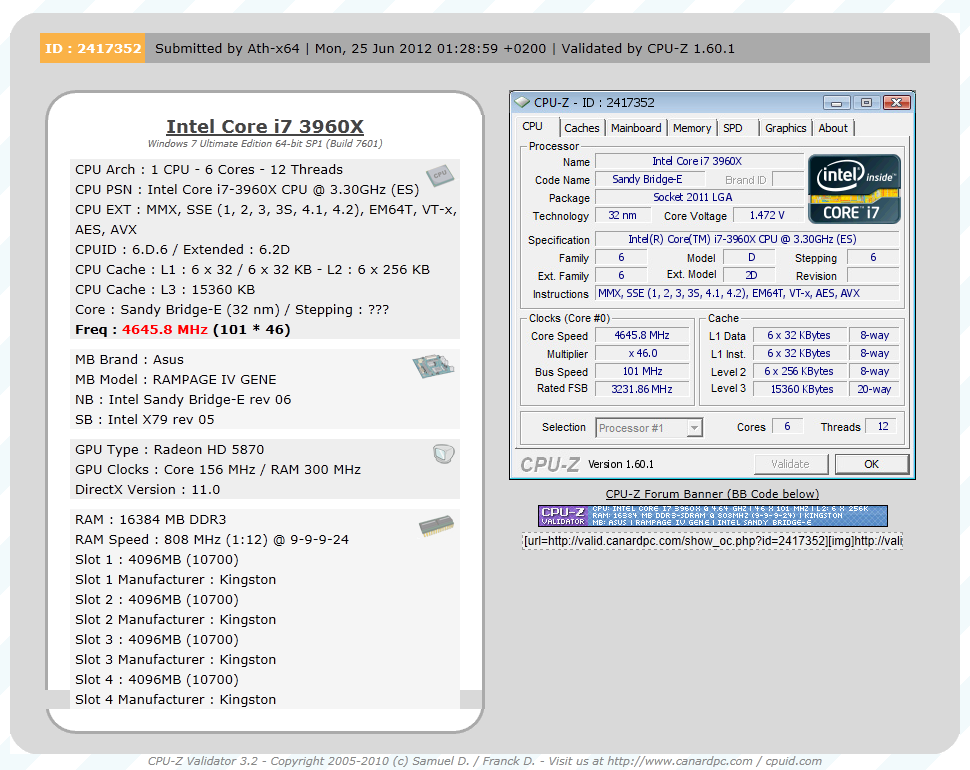
Of course overclocking is a picky subject. I can buy two identical CPUs from the store and they will not always perform the same way under stress. This is the same with motherboards, RAM and GPUs. So again it is important to keep in mind that our results represent a specific hardware configuration. Yours may be similar but will rarely be identical.
Overclocking Tools -
The tools for overclocking on the Rampage IV Gene are the same ones that we have shown you before with a few small differences. Some of the items that are available in the Maximus Line (Z77) are not yet available in the Rampage line like the auto FanXpert software. However the tools are still very complete as you will see from the video below.
The Test System and Comments - Our test system is built on an open bench. This has two effects on testing. First it allows us to see everything and also to setup and disassemble the test rigs quickly. Second it means that we cannot gauge the potential air flow found in a normal case. The air is pretty stagnant; some may say this is a great neutral testing method and it can be. However, it does mean that the temperature reading taken off of the components are not accurate to what an average consumer would see. This means that your thermal performance will vary from what we see here.
Our test system is built on an open bench. This has two effects on testing. First it allows us to see everything and also to setup and disassemble the test rigs quickly. Second it means that we cannot gauge the potential air flow found in a normal case. The air is pretty stagnant; some may say this is a great neutral testing method and it can be. However, it does mean that the temperature reading taken off of the components are not accurate to what an average consumer would see. This means that your thermal performance will vary from what we see here.
When tinkering around with the Rampage IV Gene we ran into a couple of issues during the initial setup. For some reason the board did not want to run at 1600MHz memory and an auto multiplier for the CPU. We saw this with our Kingston 1600MHz memory that we use to all of our reviews. The board would POST (Power on Self-Test) and then reboot. From there we would be presented with an error saying that overclocking had failed and that the CPU multiplier might be set to lower than 13. In the end after allowing the board to boot up at 1333MHz and run the full installation of Windows we were able to set the memory to the 1600MHz we wanted and leave the multiplier set to auto. We were not able to replicate the original error, but we did want to include it in case you have any issues.
Other than that one minor error the board was quickly installed, setup and running. The driver installation was simple thanks to the Asus InstALL. We do highly recommend performing a custom install over the blanket installation so you will not end up with Norton 360, Chrome or Google Desktop, but if you are in a hurry you can get these too. Our biggest problem with the inclusion of these is that Asus filed them under “drivers” these are applications and not drivers; they really should not be part of the driver installation at all.
Performance testing overview
Our testing is a little different than most. We combine both synthetic and real-world applications to simulate the types of performance common to the individual products. For motherboards this means that we run roughly six synthetic tests and two real-world. We will be expanding the real-world testing in the near future. But there is more to performance than just the raw numbers. As there are multiple components and sub-components on a motherboard there each item can have a distinct impact on the way the product will perform once you get it in your system. It is important to note not only the actual results but what they mean to you as a potential consumer. We will try to give this information to you.
But we do not just cover the performance aspects that are measurable. We also talk about the components that might not have a direct benchmark. These are items like Audio Quality, ease of use and installation.
Section 1 Subsystems
Memory -
Memory performance is very important on a motherboard, especially when you have a CPU with multiple cores and threads. If you have slow memory your cores and threads can become starved for data to execute. To test memory performance we run both Sisoft’s SANDRA. These two combine to not only give us accurate numbers but to validate each other. For testing at stock speeds the memory is hard set to 16000MHz while overclocking testing is done at the highest stable speed for the voltage of 1.65v this is due to the different memory dividers for each CPU. As such, the memory speeds will vary greatly. This means that the overclocked numbers are a little misleading and while they can show a trend are really only included to show if a board has a problem with memory performance at high clockspeeds.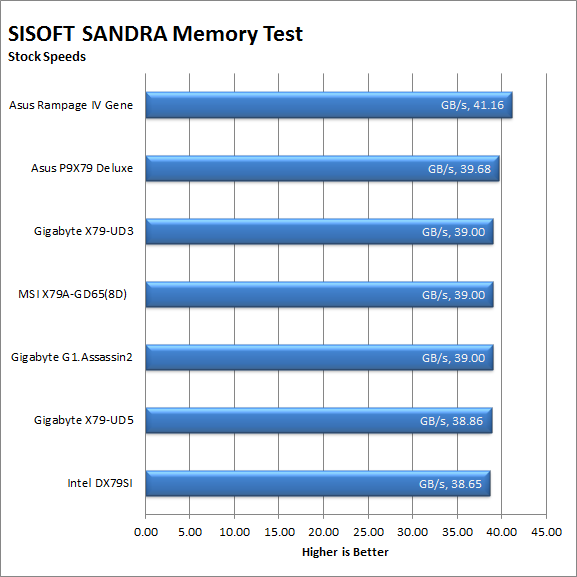
The Asus Rampage IV Gene showed off some outstanding memory performance during our testing with a solid 41GB/s potential bandwidth at stock speeds. During our overclocking run this bumped up a bit but did not scale as well as some of the other boards we have tested. The stock numbers are good news for consistent performance with multiple apps open and also when running applications that buffer a lot of data to memory (like many games are doing). We will have to see how these raw numbers compare to real-world applications.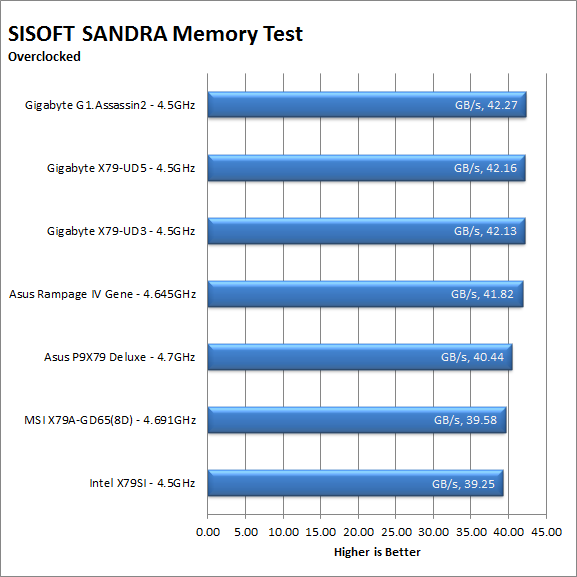
Drive performance -
Drive performance is also one of the major subsystems that goes to make up the performance of a motherboard. For our testing we use Sandra. We only test with single drives for each type of controller present on the motherboard (unless it is a professional product where we will use RIAD 5 and/or 10). We have also begun using a Seagate PS-110 USB 3 external HDD and a Kingston HyperX USB 3.0 Flash drive for our USB 3.0 performance. As a side note, we include the overclocked numbers here to make sure (again) that you are not going to see a major drop in performance due to minor instabilities at high clock speeds.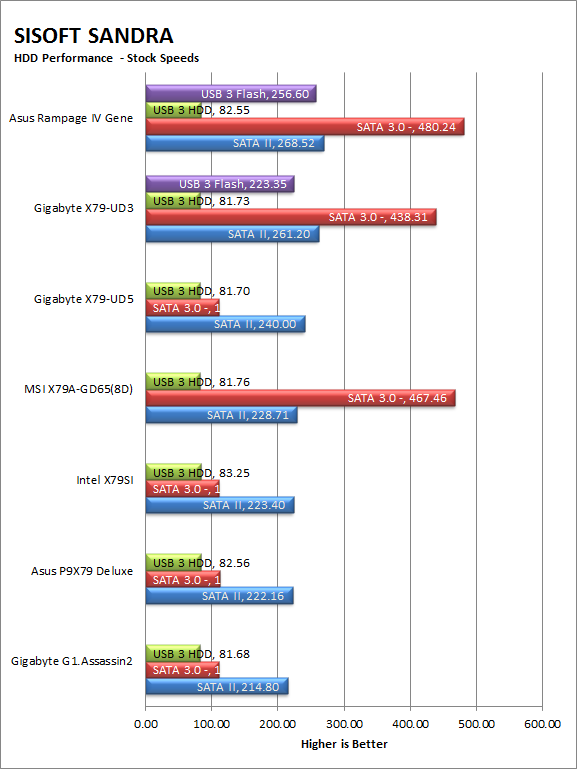
The Rampage IV Gene had the best HDD performance out of the group that we have had in the lab. Even comparing SATA and USB 3.0 in the mix The Gene simply stood out over the rest with some very impressive read times. As with our raw memory performance the numbers here are good news for potential performance with game load times, installation times and even rendering and video encoding will benefit from good drive speed.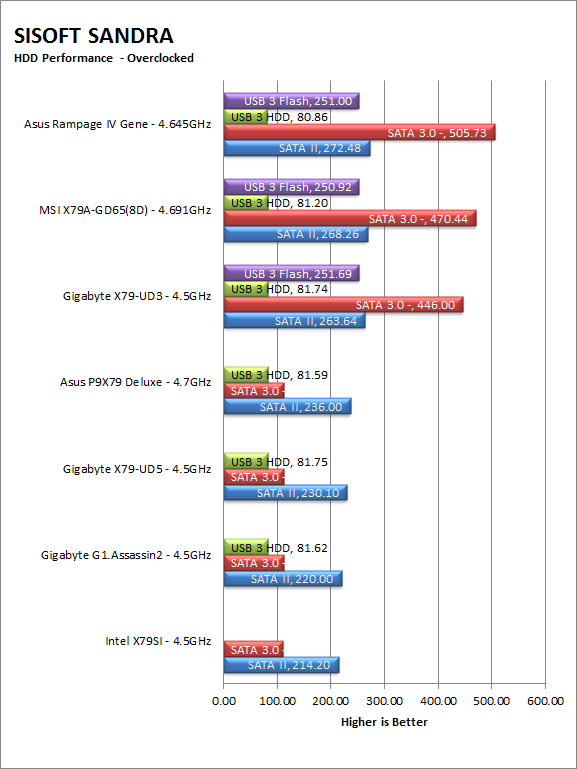
Power -
Power efficiency is another of those misnomers that we get caught up in. We hear about idle states and power gates. But what does that mean to you and I? On the surface having power management that reduces idle power sounds great and can be a benefit to someone that leaves their system on for long periods of time (and inactive) but how a system handles power under load and the delta between the two states is often more important than the idle power usage numbers. We use only P3 Kill A Watt instruments for measuring power.
Although we were more than a little surprised that the Rampage IV Gene did not do better in power efficiency we are also not too disappointed. The Gene is meant to be an enthusiasts’ motherboard and to be able to provide power when needed.
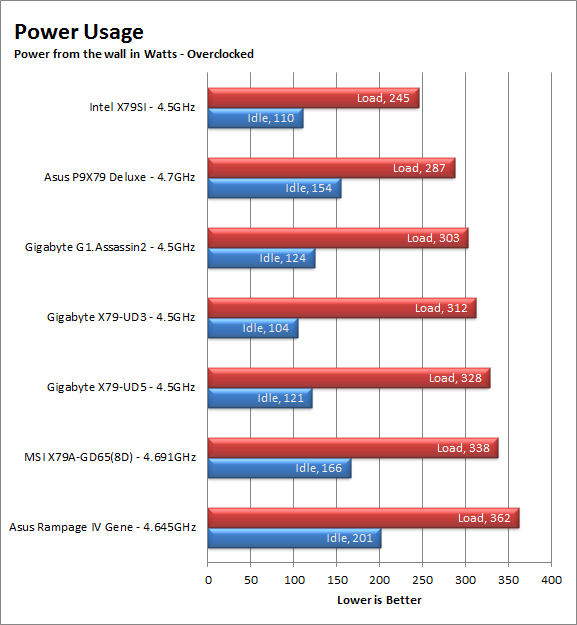
Cooling (Board Level) -
Board level cooling is an important factor in product performance and longevity. Components like the chipset, VRM modules and even capacitors need to be kept relatively cool to prevent failure. As these parts are made of silicon, they have a thermal breakdown threshold; or melting point. At that temperature the actual transistors built into chip will begin to deform and break down. Granted, the threshold is often very high, but you still need to make sure that components stay away from this level of heat for longer product life. 
The IV Gene fell into the middle of our group for heat generation which is not all that bad considering the higher level of components on the board. This means that even though it was not the coolest running board you are not going to have major issues with component longevity.
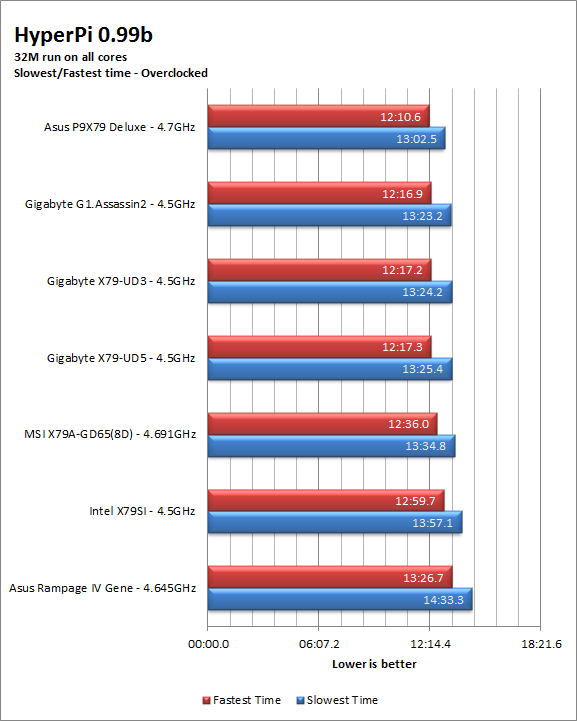
Audio -
Audio is highly subjective. What we find pleasing may sound “off” to you. That is always going to the problem with testing audio; results will vary too widely depending on the tastes of the listener. However, there are ways of measuring the audio output with an objective ear. There is also the issue of audio causing performance issues in gaming and video playback. The reason this is a potential source of concern is that all onboard audio CODECs (Compression/Decompression) are CPU controlled. This means that while the audio chip controls the audio levels and effects of the audio the actual work is done on the CPU. Usually this will not be a problem with today’s powerful CPUs. Even the lower and consumer level products can handle high-end audio these days. But again there is the chance that a bad design or software will hinder your system and performance. On the other side the limits of board space, cost, etc will also prevent the level of audio quality you can get from an add-in board. We test all audio parts with three media types, Movie (DVD), MP3 Music, and Gaming. These are pushed to our Tec On model 55 Tube Amp to see if we can detect any signal issues in the reproduction. 
As we have mentioned before Asus has started to focus on the rest of the motherboard to differentiate their products in the market. We have already seen them attack the issue of cooling with solid fan profiles and extra fan headers and now we are seeing them work on the audio components. On all of the ROG boards Asus is creating a PCB separation between the audio components and the rest of the motherboard. This does have a small but noticeable effect on the audio quality by preventing some signal loss and signal crosstalk between traces (especially when overclocked). We found that the audio was better than many boards out there with good separation in most of the audio sources we fed through it. Asus has also included Creative Labs X-Fi audio software (which includes some nice Dolby enhancements) as well. These combine with the original engineering to give you audio that is a cut above most integrated designs.
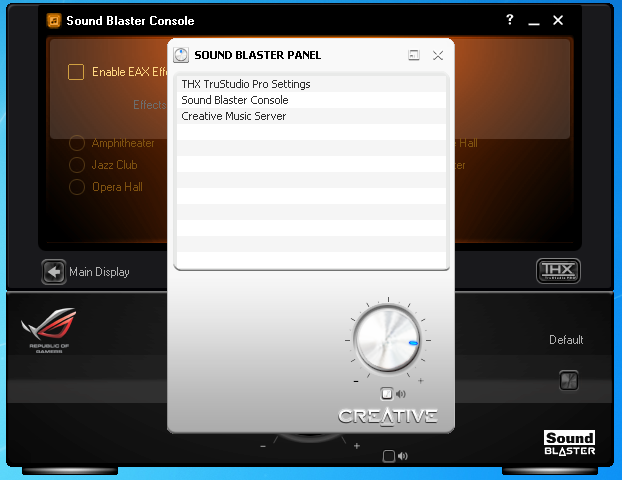 |
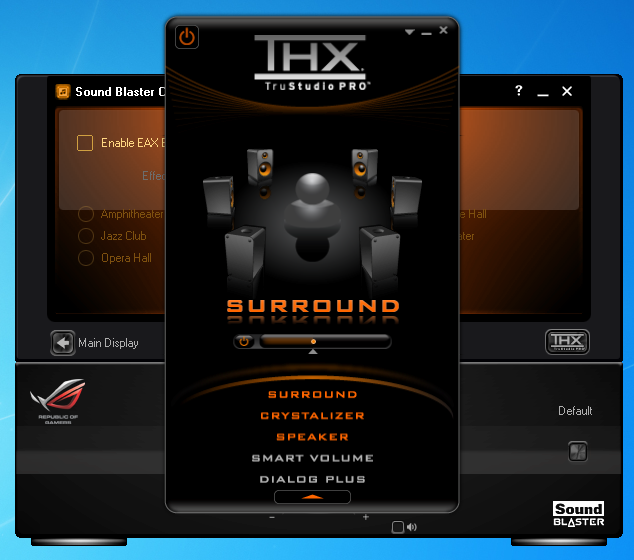 |
Networking -
This one is something that is a requirement anymore. If you have a computer, the chances are good (like 99%) that you are also connected to high-speed internet. With this you need a good and solid LAN chip to make sure that your data flows properly out and back.
Asus has moved to Intel LAN controllers on almost all of their Motherboards. Because of this we are seeing a nice improvement in sustained network bandwidth. This is over the more typical Broadcom or Realtek controllers that other companies are still using. The benefit to the end user is consistent performance over spikes in network throughput.
Section II - Performance Tests, Synthetic
In this section of testing we cover the synthetics. These are tests that run a scripted sequence of internal APIs or that use another installed application to perform a series of scripted events. They are great in that they can provide reproducible results across various platforms. On the down side, synthetic tests can be fooled with driver tweaks and optimizations. In some cases it is necessary to rename the .exe file to something generic to discover if this is the case. In any event when this is needed (when a test shows a drastic difference in performance over the renamed exe) we will note this and show both results for comparison.
PCMark7 -
PCMark7 is the latest general performance test from FutureMark. As each generation of this benchmark has evolved and developed we have watched them add more and more realistic tests to this suite. With this generation we find more media tests, (audio and video transcoding) moving of large files, multiple web page rendering, and much more (the even added DX10 gaming). We use the Overall Performance and Common Usage suites in our testing.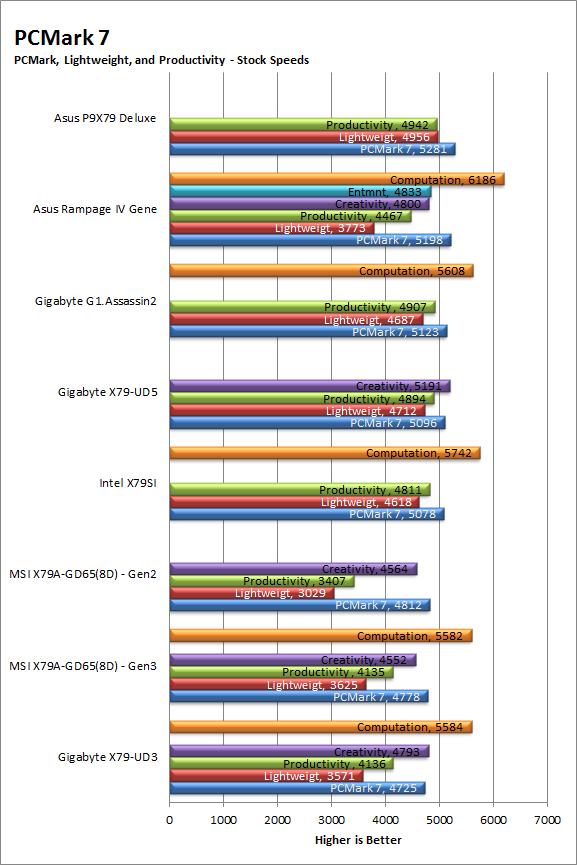
With PCMark7 our general computing synthetic test we saw the Gene doing very well at stock speeds. It was right behind the P9X79 Deluxe which is a very solid board and one that showed us some great promise. This looks good for people that are looking for a board with solid workstation, gaming and content creation performance, but PCMark7 is only half of the story.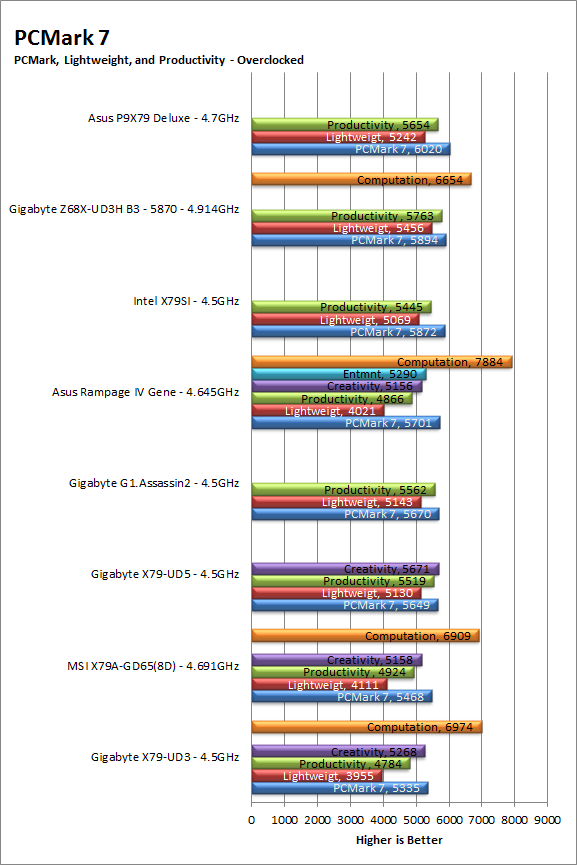
3DMark 11 -
3DMark 11 is the other Futuremark test that we run on our motherboards. This test simulates the typical tasks that a GPU (and system) would have to perform to provide you with a good gaming experience. It is based on the DX9, DX10 and DX11 engines but can only be installed on Windows Vista or later. The suite of tests covers DX9, DX10, and of course DX11 rendering; it also covers AI computations and physics. That’s right I said Physics the latest version of 3DMark uses a Havok physics engine. This removes the advantage that nVidia had with 3DMark Vantage.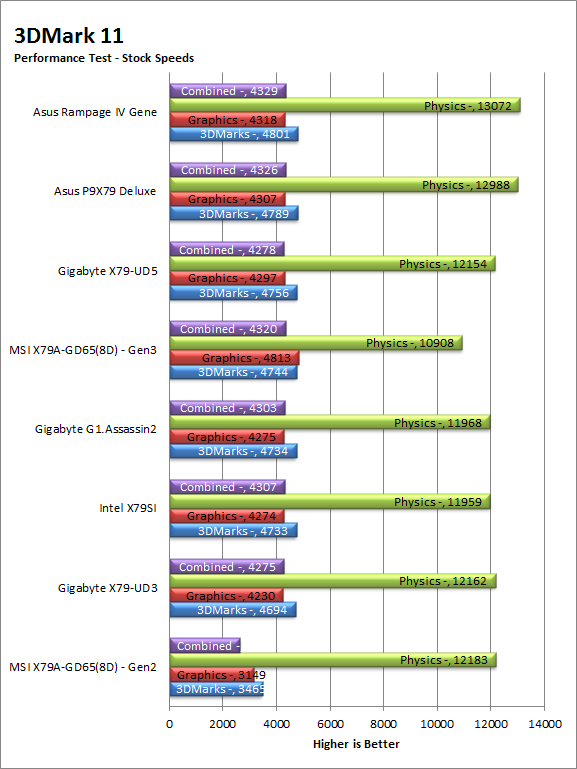
The Rampage IV Gene shows off again under 3DMark 11 by coming out at the top of the list for both stock and overclocked testing. This is good news for you gamers out there… well that is if the performance we are seeing this this synthetic test are in line with real-world gaming.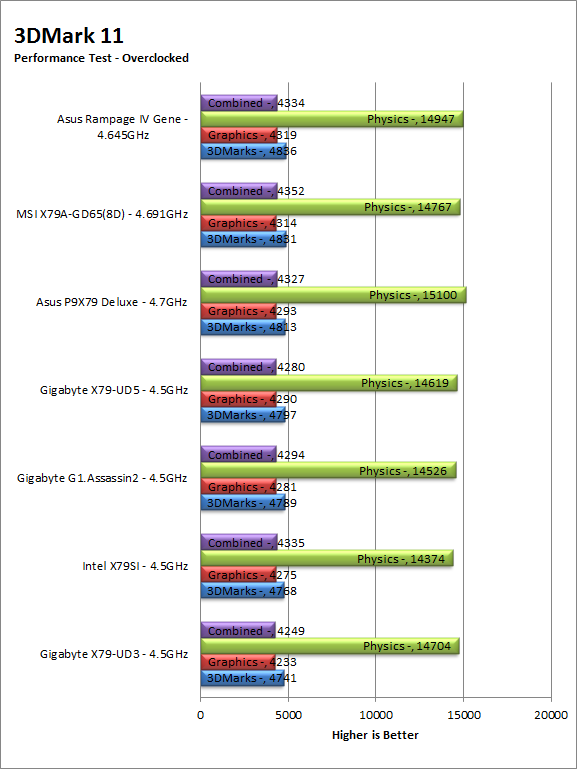
HyperPi 0.99b -
HyperPi is a front end application that allows you to easily run multiple instances of the SuperPi application. SuperPi, for those that are not familiar with it, is an application that measures the time it takes to calculate the number Pi out to as many as 32 million places. This calculation is then checked and run multiple times (up to 24 for a 32M run). This test stresses the CPU, Memory and HDD as data is handed off between the three. If there is a weak link, HyperPi will show it. For our testing we run the 32M test on as many cores (and threads) as the CPU has available. The slowest CPU time is then recorded.
Again at stock speeds the Rampage IV Gene does a great job coming in right behind the P9X79 Deluxe. Unfortunately when we overclocked the board it dropped like a stone. The performance numbers here when the CPUs are at 100% load and under stress are concerning. This may end up impacting performance of real world rendering applications along with image manipulation programs and possibly transcoding.
Cinebench R11.5 -
Cinebench R11.5 is the 11th release of Maxon’s rendering test. This test is based off of the Cinema 4D engine, which is one of the industry standard tools for digital animation. It is a powerful product with many different modules that can be “plugged” into it to increase its effectiveness. With Cinebench you get to see how your computer would do using this application. There are two tests; one tests the CPU’s ability to render an image across multiple cores or threads. The other tests your systems ability to handle OpenGL based rendering.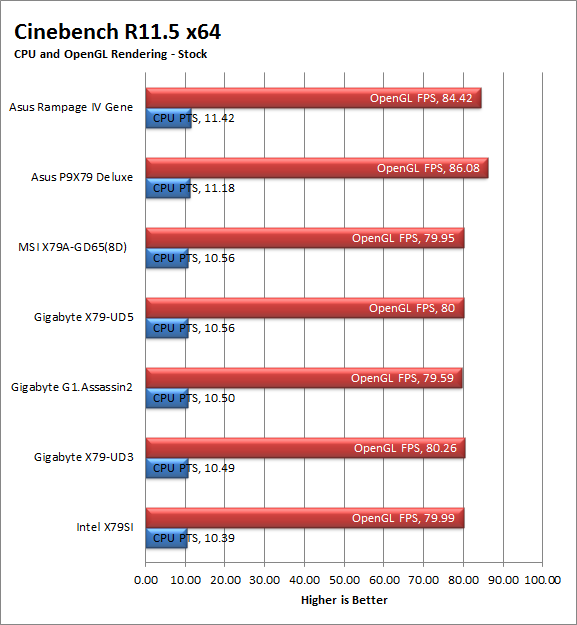
The Rampage IV Gene did very well under Cinebench R11.5 at stock speeds, but again fell behind when overclocked. We would have expected it to scale a little better than what we are seeing here to be honest. We hope that we do not see the same impact when we run our LightWave testing later.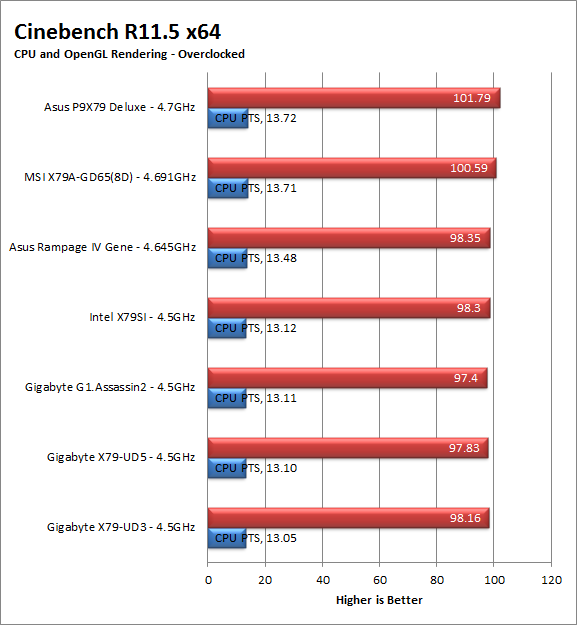
Section III - Performance Tests, Real-World
Here we have two tests that are designed to put the performance of the motherboard and its subsystems to the test. Both require good CPU, Memory, HDD and even to a lesser extent audio and network performance. The two tests we chose were Lightwave 3D 9.6 and AutoGK 2.55. We will be adding at least one more real-world test to this battery in the near future, but for now these two cover quite a bit.
Lightwave 3D 9.6 x64
Lightwave is another industry standard application for 3D animation and rendering. It has a large tool base and the rendering engine is highly threaded (when using the right render model). This application is also capable of expanding to 4k resolutions as well as ray tracing for rending the light sources. For our testing we use frame 470 of the Pinball scene found in the LW 9 Content folder. This uses the newer perspective camera that is better suited to a multi-CPU/Core environment. This camera style also uses ray tracing and a much improved anti-aliasing method. Settings are shown below in the attached screen shot. Of course these are single frame renders and they are not a complete picture; for that you have to take into account the number of frames an average project would have. In a typical 30 second commercial you will have around 840 to 960 frames (at 28 – 32 FPS) this means that you have to multiply the time of a single frame by that number just to get a vague idea of how long that 30 seconds would take. This is because each frame will have a different render time based on complexity.
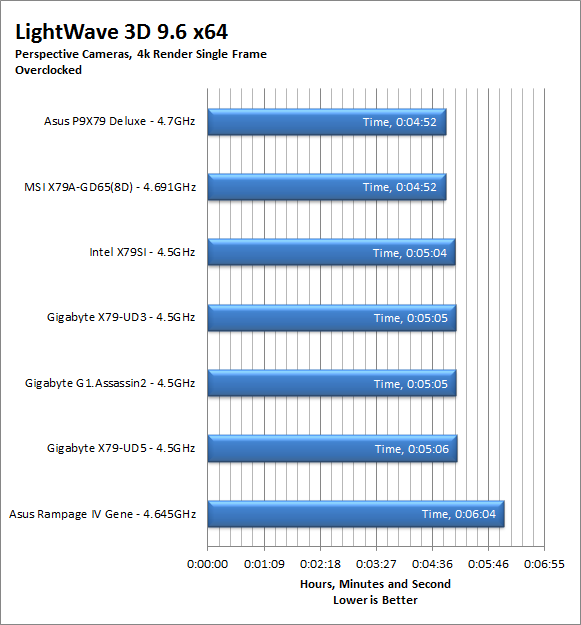
Remember that issue we told you about with HyperPi? Well it has come back to haunt the Rampage IV Gene here in LightWave. What we are seeing is outstanding performance at stock speeds, but something is throttling it back when the system is pushed. We are sure that this is an issue that a BIOS update can fix though so while this performance showing is disappointing we are not too concerned about it just yet.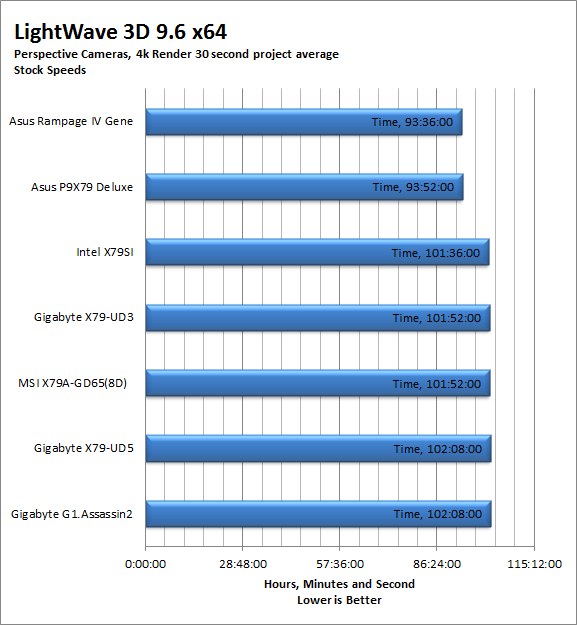
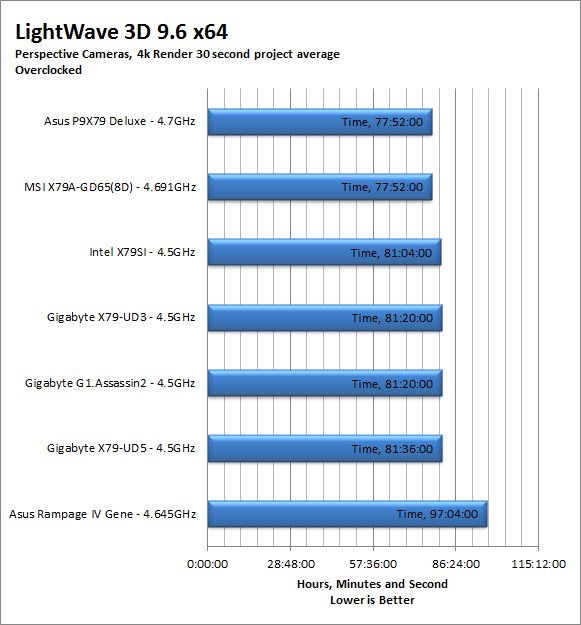
CyberLink Media Espresso 6.5 -
After having various issues with AutoGK and Intel CPUs with more than four cores we have changed our Media Encoding test to use Media Espresso from CyberLink. Although this new utility does not have the same ability to transfer directly from DVD it is still a good test to transfer different media types into a usable format for your iPad, iPod, or other media player. Our test involves using multiple (Six) 20 minute media files and transcoding them for an iPad. This gives us a very good indication of how well a motherboard can handle this type of work load.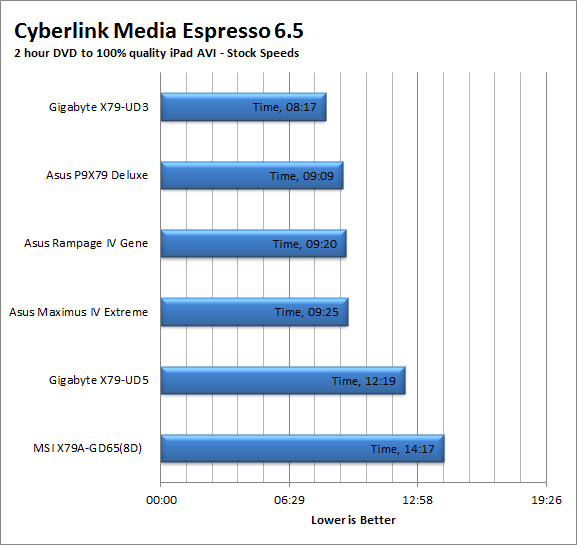
The Rampage IV Gene did fairly well at transcoding although it was not as fast as it should have been when compared to the other boards we have tested. What was surprising was the overclocking the board did not slow things down like we have seen with other applications we use for testing. This is a good thing to know as it makes it more clear that this is not a design issue, but more likely a BIOS tweak that can be corrected.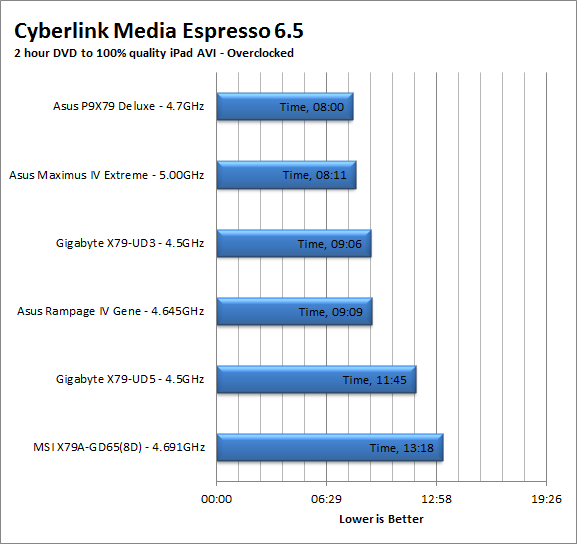
Section IV Performance – Gaming
Gaming as a test of motherboard performance is sort of a joke these days. The big player in the gaming arena is the GPU. Everyone but a few hardcore PR teams know this. However, it is important to run at least a few (one from each current DX version) to see if there are any issues with the combination of components on a motherboard. These are items like Audio lag, memory lag and of course problems with the PCIe lanes and signal traces. If there are issues in design, drivers or BIOS then you can have odd gaming performance. So without much more preamble let’s dive into the three games we currently use; Call of Duty Modern Warfare 2 for DX9 FarCry 2 for DX10 and Battlefield Bad Company 2 for DX11.
Call of Duty Modern Warfare 3 DX9 -
As the third installment in the Modern Warfare franchise you are picking up some old roles while adding a couple of new ones as well. The game play is almost identical to what you are used to in Modern Warfare 2 as are the graphical settings. The AI is a little different thought it is still similar to the bar fight style AI we like in the Call of Duty series. For our testing we run the first mission (Black Tuesday) from start to finish. Settings are shown below
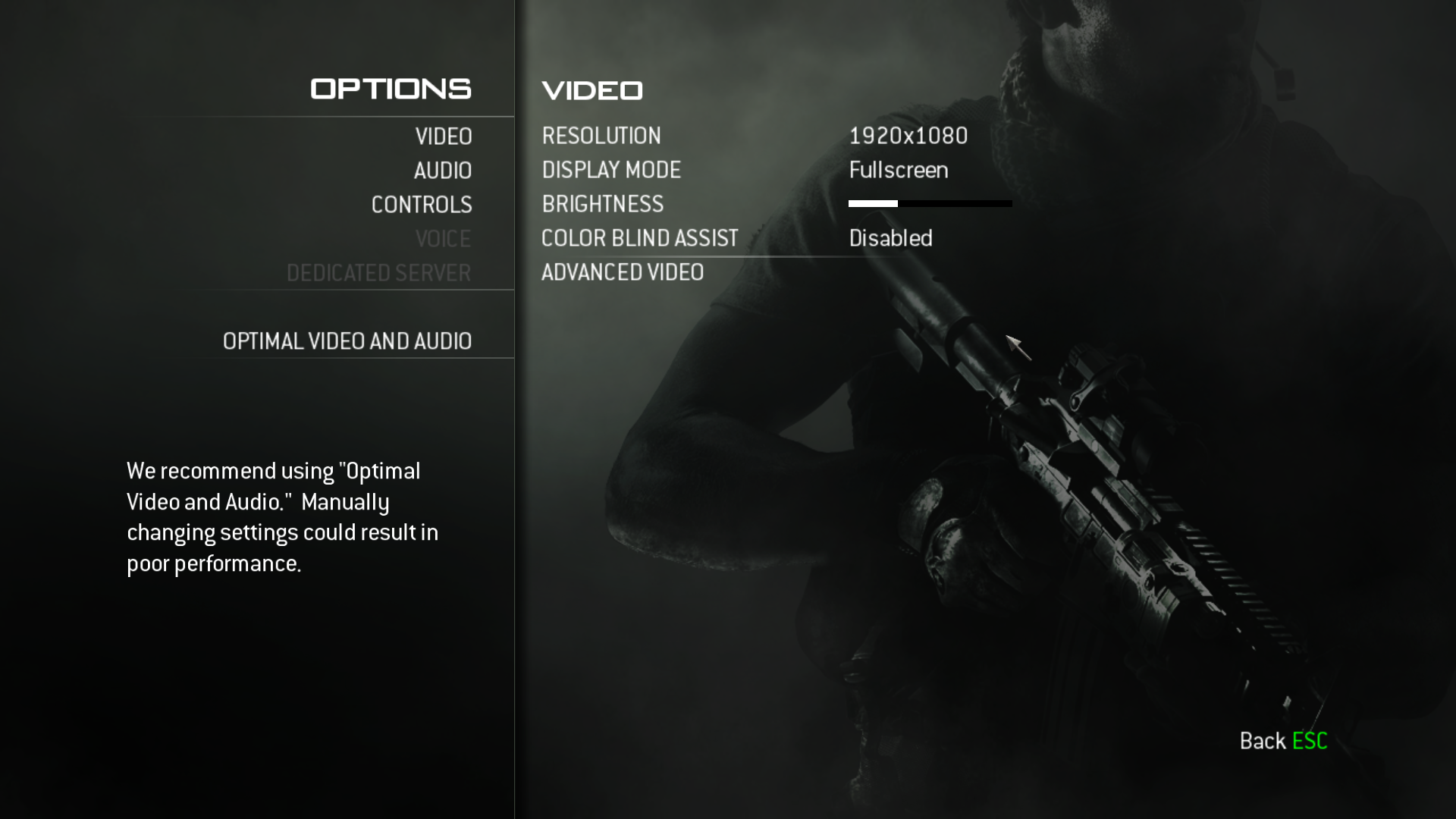 |
 |
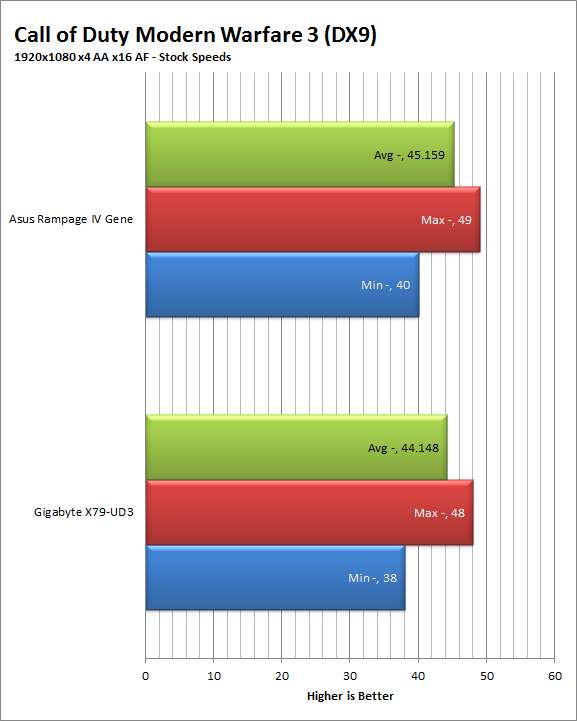
In gaming things are close with regards to motherboards and how they operate. Looking at the numbers here you can call a “winner” but you could put these two systems side by side and you would not be able to tell them apart visually. Where you would see a difference is in things like level load times, audio quality and the general feel of the game. The Rampage IV Gene has that and it showed during our testing time with Modern Warfare 3.
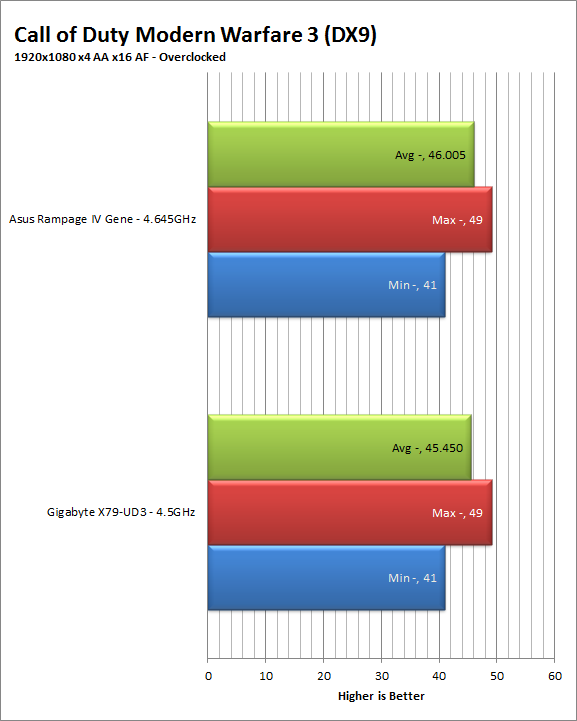
FarCry2 DX10 -
Although not one of my favorite games this tedious game does have some good graphics. The large sandbox style of the game lends to mission based play. The only problem is that the AI is rather low grade. Still the more CPU power the more the bad guys try to do. Over all the game was a little bit of a disappointment to play, but still not a bad DX10 representation. Our testing run starts right after you get your first mission to clean out the safe-house and ends after the hostage rescue. Settings and performance numbers are shown below.
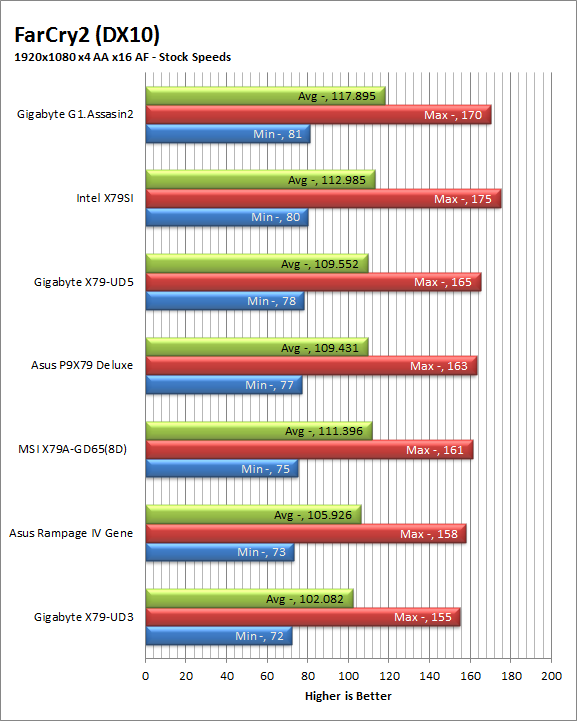
In Farcry2 the Rampage IV Gene was a little less than average at stock CPU speeds in terms of where it stands in the systems we have tested it against. Even taking the average frame rate into consideration it is not that good. When the board was overclocked it picked up the slack and was able to really shine. Again, as with Modern Warfare 3 we saw very quick level load times and had good audio from the Supreme FX III sound that comes with the Gene.
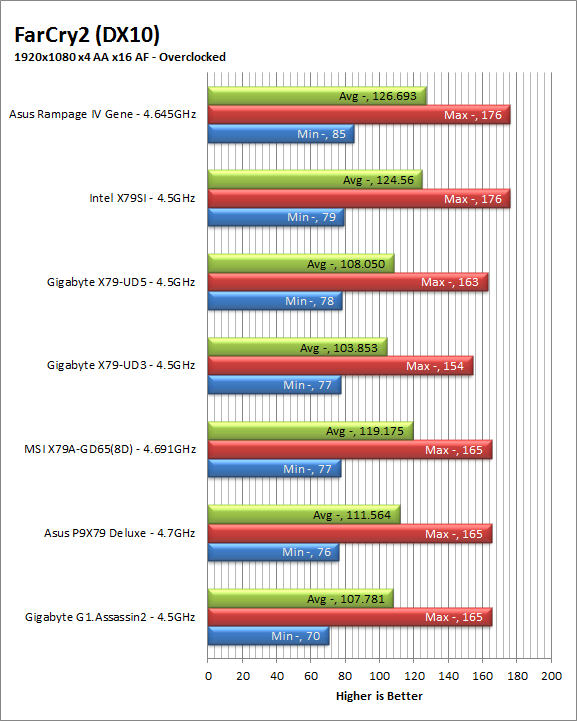
Crysis 2 DX11 –
Another sequel Crysis 2 follows up on two other Crysis games (making the title a little misleading). You take the role of a Force Recon Marine who is given a battle suit by a character named Profit (you will remember him from the other two Crysis games). From there you run around an Infected and Invaded New York City trying to survive and, of course, save the planet. For our testing we ran through the first “mission”. Settings are shown below.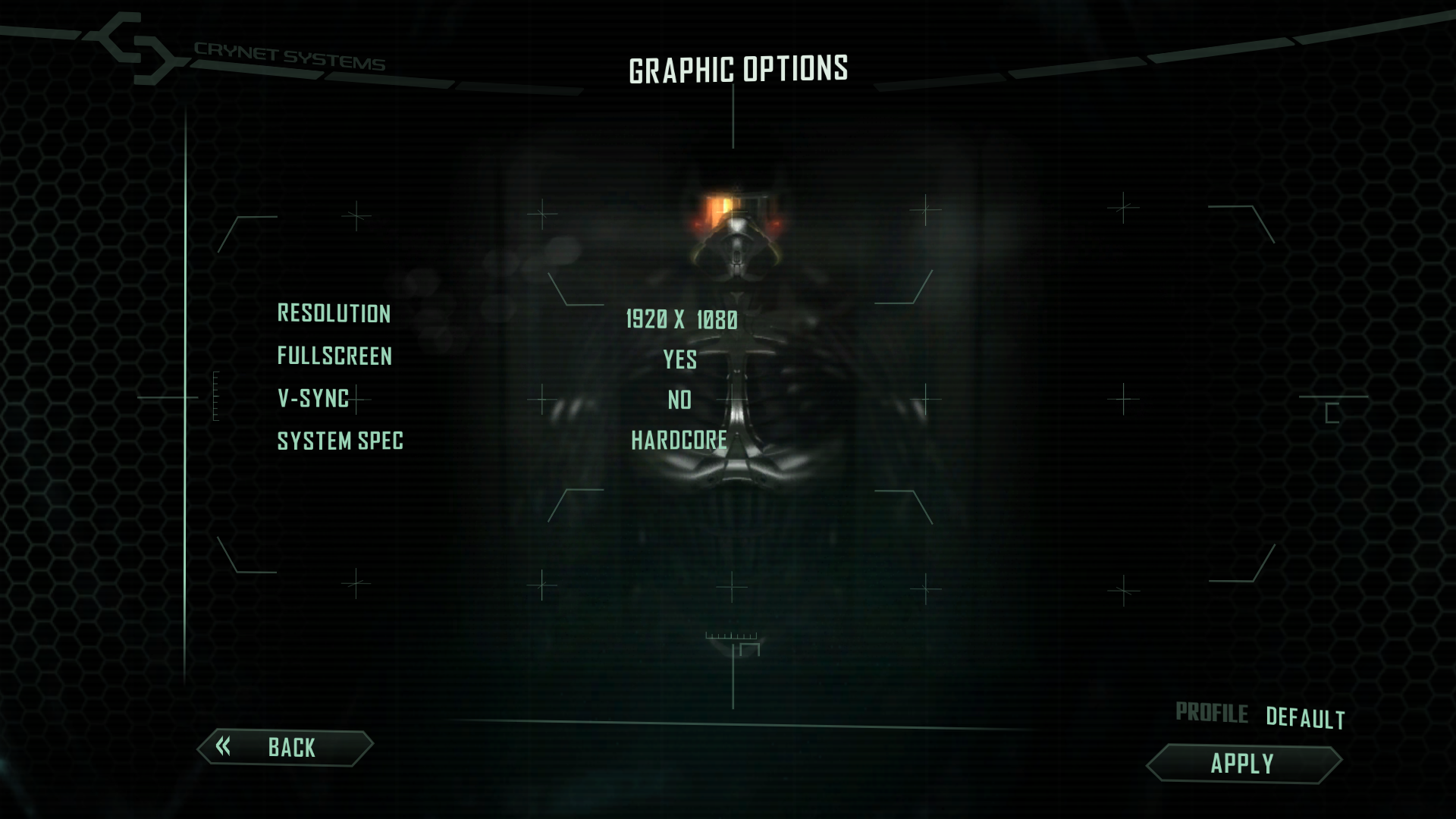
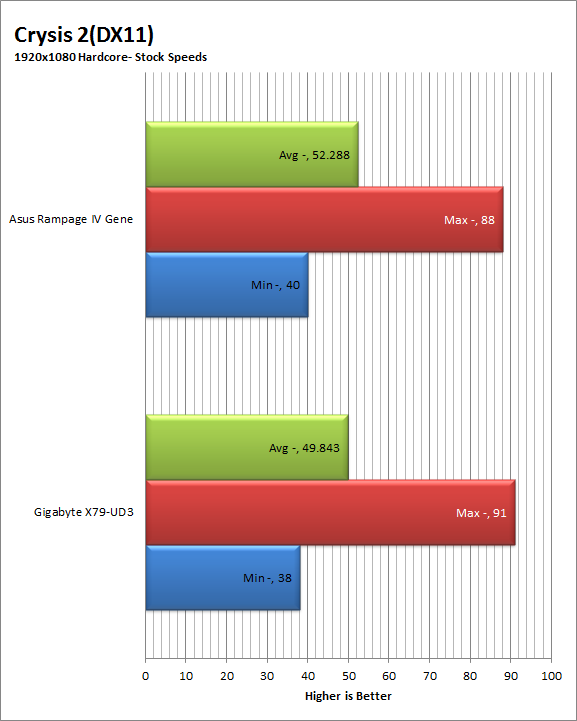
With Crysis 2 our test subjects are so close we are not even going to bother trying to call out frame rates. We will say this, the Asus Rampage IV Gene did have much better level load times and also featured a more immersive audio experience (especially with headphones) than the other boards we tested.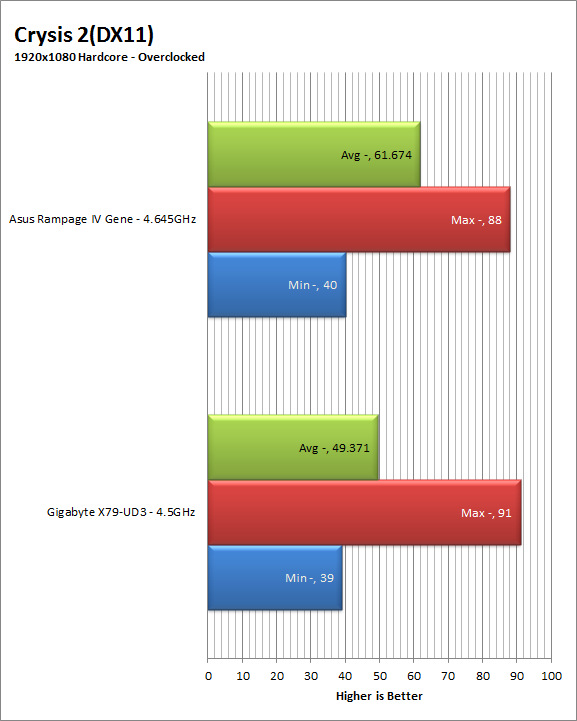
Gaming wrap-up -
As we have said above there is more to gaming than just frame rate (although that is a big part) there are items like audio quality, level load times, AI responsiveness, and more. On many motherboards these days these items are overlooked. Sometimes they are overlooked to save costs, but in some cases they are missed because manufacturers think that a part is “good enough” what we found with the ROG Rampage IV Gene is that good enough did not make the cut and the gaming performance shows this; not in terms of frame rate, but in the overall gaming experience.
Value -
Value is another very subjective topic. What is expensive to some might be a deal to others. You can look at this topic in multiple ways. One is raw price and the other is what you get for the money. Each is accurate and both are correct ways to look at price/value. We tend to look at features, performance and real-property when we discuss value. However, we also take into account the raw cash cost of the item. The Rampage IV Gene will put a $280 dent in your wallet from most online stores. On the surface this is a lot to pay for a hardware component, but when you start talking things apart and looking at what you are getting then things might look a little different. With the Gene you are getting some very good quality components along with some great overclocking and performance options that we have not been able to find anywhere else. The Gene also makes an amazing gaming motherboard for a small form factor case (perfect for LAN Parties) It is not going to be for everyone and if you are cost conscious then this might not be the board for you at this price; for the enthusiast or gamer that wants to get in on the LGA 2011 Core i7 performance and not spend a fortune then this could be the right price and the right board for you.
Conclusion -
There is not much more we can add to what we have already talked about. Put simply the Asus ROG Rampage IV Gene is an excellent product and one that has a decent price for what it is. We found that Asus’ new focus on features that matter at each price point has filled this board with a nice array of items that will fit the gamer and enthusiast. You have PCIe Gen 3.0 Crossfire and SLI complete with Intel LAN and a PCB separated audio CODEC. You have an excellent BIOS interface in Asus UEFI with their Digi+ power controls and more overclocking options that most people will know what to do with. We did run into a few issues with overclocking where the performance was not as good as we would have expected. However, with Asus’ BIOS support team we are sure they will fix the problem pretty quickly. The Rampage IV Gene also has the best memory and HDD (SSD) performance that we have seen in an X79 motherboard. We were very impressed with its performance there and it showed in most of our tests. The Asus Rampage IV Gene is one solid little board and one that you should consider even if you are not looking for a MicroATX motherboard.
With its solid performance, great features and overall user experience we are happy to award the Asus Rampage IV Gene our Gold Key Award.
Discuss this in our Forum

